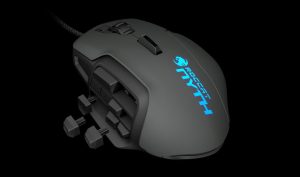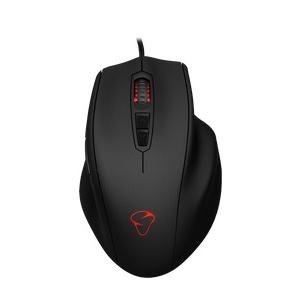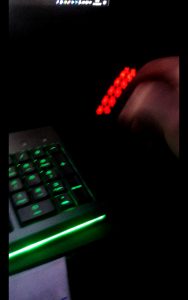Whilst I was browsing for a new keyboard a few months back, as mentioned in my Cougar 200K review, I decided it was also time to replace my mouse at the time, the Razer Imperator 2012 edition with something a little less beat up. Whilst I was looking at the Roccat Ryos keyboard, I was also looking at my heart’s desire, the Roccat Nyth mouse, that has 16 side buttons capable to be arranged in any manner, allowing for any macro to be assigned to them, includes a paddle switch that can be nudged side to side on the top of the mouse and has interchangeable side plates to change the mouse from a claw grip to palm rest. I’d had my eyes on this for a few years, which also had the innovative concept to allow printed custom 3D button designs and engravings, but like the Ryos keyboard, was let down with the bulky feel of it, and also that it had an annoying skirt along the rim of the mouse that caught on skin and mouse mat. I returned this back to Amazon alongside the keyboard, but I wasn’t quite yet willing to give up on Roccat.

Roccat Nyth
I will give it to Roccat, they really do push the design of current peripherals, including additional features that could be seen as worthwhile, though they do come at a cost. So we’ve seen the Ryos keyboard that has the thumb macro keys that is unique only to the Ryos, we’ve seen the Nyth mouse with switchable side buttons with countless configurations, there was even technology incorporated that allowed the keyboard and mouse to talk to each other, allowing for macros to be switched on the fly. Their designs were influence enough for me to give Roccat one last chance to try out the Roccat Tyon mouse. Again, covered in a vast away of buttons to many a MMORPG fan’s delight, though I did struggle to properly reach and activate them in time within the game (maybe it’s just me at this point with all these complaints).
The one thing that this mouse did have over any over competitor on the market was that it contained an analogue switch on the thumb side of the mouse. This switch could be either pushed down or up, allowing for an extra axis in the game to be used for which many mouse and keyboard players never get to experience. An example of when this could be used properly is flying a jet in Battlefield 4. By lifting the switch slightly up, you would speed the jet up slightly. Pushing all the way up would accelerate the Jet to its maximum speed and the exact opposite can apply when pushing the switch down. The problem though, is that there’s very limited uses for this unidirectional switch in games, as there’s usually more than one axis to control, plus it depends on a game being able to accept analogue input. If this analogue switch had instead been a small joystick on the side of the mouse, similar in appearance to something on the 3DS, then you could use that side stick for fine attunement of aiming in an fps, controlling a character onscreen using only one hand (aswell as being able to control the speed of the movement which w,a,s,d keys on the keyboard can’t allow) or even to be used to scroll through a menu in the game, like inventory whilst still controlling your character, not having to pause the action.


There is a product out there made by Logitech, the G13 that does contain an analogue stick, the problem though is that it’s attached to a device similar to a keyboard, yet missing half the keys. I’m not willing to make my ‘gaming’ keyboard redundant, wasting all that space in the middle of the desk to then pull out another device to take even more limited desk space up to perform the exact same function as the keyboard. Also, there are too many keys on the side where my little finger is, which is only strong enough to reach and press buttons one key away from its default resting place. I mostly activate skills off my keyboard using my index finger, that can pretty much reach 90% of the keyboard whilst my remaining fingers remain in their positions, so the G13 is no good for me. If only that joystick was transferred over to a mouse instead, everything would be solved, but it seems to be a taboo topic mentioning joysticks on mouses in the gaming community. It’s essentially become a gaming myth.
So after a quick play around, and the analogue stick not coming up to scratch, the Roccat Tyon was also sent back to Amazon and the search for a mouse was renewed.
When I found the Cougar 200K keyboard, I wanted a mouse to match. Thankfully enough, Cougar also offered an accompanying mouse in the form of the 200M. Again, the price was extremely agreeable at a meager £15 that covered a mouse with a high dpi and the minimum requirements of a scroll wheel and back/forward side buttons. I gave up my £60 Imperator to my little bro, whose generic gaming mouse was playing up at the time, and switched to making the cheaper mouse my main. Initially, the mouse felt okay to use, responsive with no jerking, but did feel too light to hold and the side buttons were too recessed into mouse, meaning that I had to push the plumpness of my thumb into the crevice to activate the buttons. On a budget, the mouse would have been fine to use for gaming, but I wasn’t on a tight budget, so I decided upon splashing out for something more comfortable. I put the 200M mouse aside to use as a spare, but sadly the left and right click buttons snapped off recently when I was trying to drag this out of a drawer full of cables.
Now we finally get to the point we’ve all been waiting for in this story. After much more deliberation, the main purpose of a new mouse was that it had to fit my hand as ergonomically as possible. I wanted to have a comfortable experience during long sessions of gaming, with no aches or sore skin, thus not breaking my immersion of the game. With my Razer Imperator, it had back/forward side buttons that could be shifted up or down the mouse, so that my thumb sat comfortably in the middle of the two and required very little pressure to depress either button. The only problem with this mouse was that as I have a palm rest grip, my little finger couldn’t fit on the side of the mouse, and would slightly rest on the mouse mat. This meant that over the course of a day, the side of my little finger would become sore from having rubbed against the mouse mat. Most mouses don’t offer much protection against this, a small mould of plastic at most sticking out from side of the mouse that your ring and little finger are supposed to cling onto for dear life. Well I didn’t take long to finally discover the mouse that I would settle on, the Mionix Naos 8200.

Mionix Naos 8200
As seen above, the mouse is perfectly moulded, giving a position for each finger to rest nicely on. At £80, there were cheaper versions of this mouse layout offered by Mionix, with optical sensors rather than a highly precise laser that the 8200 boasts, and ofcourse I want only the best. When it did arrive in the post, I can only describe the next part of my experience as absolute bliss. Taking the mouse out of it’s well formed packaging, I sat it down on my desk, and ever so slowly brought my hand to rest upon it, gently caressing its curves and finally snuggling my palm into its resting position. It was heaven. All of the weight of my hand was evenly spread throughout my contact on the mouse, this is what true ergonomic design has been striving for since day dot.
The hard rubbing coating is smooth to grip and offers enough friction to lift the mouse up with the slightest amount of pressure. The cable is corded, but still flexible around bends and kinks don’t get caught on the edge of the desk like my Imperator would. The scroll wheel spins with just the right amount of tension, and never skips a beat. The only physical issue I have is that I can’t reach the forward button on the side with my thumb without having to rotate my whole hand, this is the only feature of the Imperator I miss, being able to slide the side buttons to the correct point that my thumb can reach both comfortably. I abashedly acknowledge that I don’t need a billion buttons for gameplay as on the Tyon and Nyth, side buttons and middle click are more than enough for assigning important jobs to whilst anything else is assigned to the keyboard.
Even though at one point the essence of USB mouses was just to plug and play, the mouse as most of them do today, does come with software for configuring a plethora of parts in the mouse, such as assigning macros, setting dpi levels and profiles, laser height detection, RGB configuration etc. It even has a test that can scan your mouse mat surface to see how well it works with the laser sensor, my test resulted in a rating of 60%, which I don’t believe is optimal but it still works. I couldn’t use the mouse’s laser sensor at its advertised 1000Hz polling rate as it resulted in weird movement jerks onscreen, but reducing this down to 250Hz solved the problem. It actually did take about an hour of configuring and testing before I got the movement of the mouse on my ultrawide monitor to my liking. But now comes quite a big sour point about this very expensive mouse.
The RGB in this mouse is abysmal. Whilst the laser sensor can boast to have a polling rate of 1000Hz, the RGB LEDs only run at a frequency of about 20Hz. When the mouse is moved around the mat, even at a slow speed, the colouring of the RGB suffers from some sort of chromatic aberration, and so instead of seeing a desired orange glow, when you move the mouse around, or even your head for that matter, you instead see a blur of green on one side and red on the other, with gaps of black inbetween each colour band. Setting the RGB to white is the worst, as all components of the RGB are used to create this effect. If you move the mouse fast enough, you can see a trial of separate lights that goes from blue, green to red and repeats as the LED switches between each of these colours rather than showing all these colours at the same time. I think it might have something to do with maybe the mouse not having enough power to light up all 6 RGB LEDS at once, which is technically 18 lights that has to be lit up at the same time, so instead it splits the power amongst the 3 colours, meaning that for a mouse only receiving a power supply of 60Hz, each light only gets 20Hz, ie 20fps for the gamers out there, and 20fps is below the 24fps the eye requires minimum for movement to appear seamless. It’s very nauseating to look at and follow, so I have set the colour of the RGB to pure red. It’s as close to orange as I can get to match with my keyboard, but what occurs if I look at the mouse whilst moving it, is that it doesn’t suffer from chromatic aberration no longer, but there are still bands of black inbetween blocks of red light.

Exactly as seen by the human eye
Overall, my experience of the Mionix Naos 8200 is very positive. I know I waffled to get to this point, but I wanted to take you on the journey with me of how I finally found the perfect shaped mouse for a palm rest gamer, and that when those few niggles are sorted out on a future model of the mouse which hopefully includes the existence of an analogue stick, I will have finally found supple heavenly perfection.










